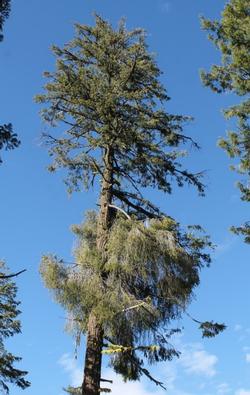Douglas-fir Dwarf Mistletoe (Arceuthobium douglasii)
Trees Affected
Common: Douglas-fir
Occasional: True firs and spruces
Summary
Douglas-fir dwarf mistletoe (Arceuthobium douglasii) is a parasitic plant that primarily lives on Douglas-firs but occasionally is found on true firs. Although the visible parts of this plant are less than one inch long per stem, this plant can have a significant negative effect on its host tree’s water status and growth, and causes large, drooping witch’s brooms that are prone to becoming fire ladders during burn events. Host trees may persist for many years while hosting dwarf mistletoe, but will likely experience gradual crown decline due to water and nutrient loss to this parasite. Once established, populations of dwarf mistletoe tend to build up within a stand due to their explosive seed dispersal strategy, which results in a gradual accumulation of dwarf mistletoe in the host tree and of other nearby trees. Douglas-fir dwarf mistletoe is considered a major pathogen elsewhere in western North America, but is confined mostly to high elevation sites in northern California. Although it has the ability to incur severe damage via wood deformation, tree mortality and increased flammability, this dwarf mistletoe also creates valuable habitat for mammals, birds, and insects. Additionally, this plant helps diversify stand structure by creating standing dead trees and opening up canopy gaps. However, dwarf mistletoes may become a more significant stressor on their host trees as this region gets warmer.
Local Distribution
Relatively common in dense, high elevation Douglas-fir stands, especially where fire has been absent.
Management Strategies
Although the north coast is home to many species of dwarf mistletoes, most species of these parasitic plants are specialized to live on only one to a few species of host tree. Douglas-fir dwarf mistletoe only regularly parasitizes Douglas-fir, with occasional infections on true firs and spruces. Therefore, one effective management strategy is to maintain a mixed species stand to prevent total stand loss in the event of dwarf mistletoe infection of a single species of host tree. Other management strategies include removing infected trees or branches, though the latter is only effective if the infection has not reached the trunk yet.
Pests and Pathogens with Similar Symptoms
Other Dwarf Mistletoes: The fir dwarf mistletoe (Arceuthobium abietinum) primarily targets true firs, but may also infect Douglas-firs in areas where species overlap. However, the vegetative parts of this species are usually longer than an inch, and the witch’s brooms produced by it are more compact and less droopy than the Douglas-fir dwarf mistletoe. The management strategies listed here are also recommended for the fir dwarf mistletoe.
Further Reading
Comprehensive overview of dwarf mistletoe biology and control:
https://www.fs.fed.us/rm/pubs_other/rmrs_1996_hawksworth_f001.pdf
Summary of biology, impacts, and nuanced examination of management options:


